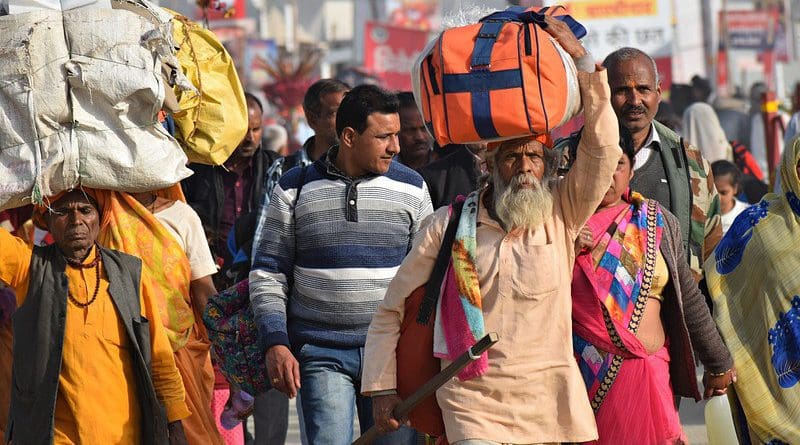Why Is India Resilient To Oil Volatility, Despite Overdependence On Imports? – Analysis
Pan-India outrage has spiraled with the soaring inflation and government’s inability to control it. Angers has been hurled against the government’s failure to seize the oil price hike and its impact on inflation.
Inflation (measured by Consumer Price Index) increased by 6.34 percent in 2021-22 as compared to 5.01 percent in 2020-21. It accelerated in the first three months of the current year 2022-23, despite the government reducing petrol and diesel prices by lowering excise duties.
Clamour sparked over the repeated hikes in petrol, diesel and LPG prices. In between March to May 2022, petrol and diesel prices were hiked 4 times. It was reduced from May’s end, after the reduction of excise duty. While comparing with prices in most of the Asian countries, who are dependent on crude oil import, Indian prices are now lower. For example, as compared to Delhi price of petrol at Rs 96.72/ litre, in terms of the Indian rupee, petrol prices were Rs113.96 / litre (US $1.44) in Vietnam, Rs 114.68/litre (US $145) in China, Rs102.22 / litre (US $1.29) in Burma, Rs119.80/litre (US $ 1.52) in Thailand, Rs123.77 (US$ 1.57) in the Philippines , Rs149.05/ litre (US $1.89) in Laos and Rs239.26 /litre (US $ 3.03) in Hong Kong.
Oil price hike VS inflation
Nevertheless, did really the oil price hike increase inflation in the country? The government records say a different story. Factors attributing to inflation were food articles, and not oil based fuel prices. Food inflation increased by 7-8 percent in the first two months of current year in 2021-22, as against a 4 percent increase in fuel and electricity prices. Food articles have the biggest weight in the CPI Index (45.9 ) and fuel and electricity have less weight in the index (6.8). This infers that the increase in overall inflation was mainly due to food articles. Weight in the Index indicates the significance of the sectorial impact on inflation.
But, the aggrieved people are reluctant to believe the government statistics and argue that the reality os different. They claim that even though the oil price hike had a less direct impact on inflation, it has an indirect impact through food inflation. This is because most of the food articles are transported by road, due to poor railway logistics.
However, challenging the people’s perception, a Nomura report argues that food inflation was due to higher feedstock and uptick in MSP (Minimum Support Price). Besides, a global protectionist policy on food has an impact on the inflation in the country, according to the report.
Oil dependency Vs GDP
India is the 3rd biggest global importer of crude oil. Over 99 percent of its crude oil required is met by imports. Domestic production of crude oil remained stagnant over four decades in the absence of new recoveries. This resulted in an overdependence on crude oil imports.
The last hike in global oil prices was during 2011-12 to 2013-14. During this 3 years period the average Indian basket price of crude oil was US $111 per barrel, as against the average price of US $77 per barrel in the preceding 2 years. Notwithstanding, India could sustain a normal GDP growth, which was at average of 5 to 6 percent over the same period.
Oil is not the major source of energy for the growth parameters of the Indian economy. Coal is the prime source of energy.The major sectors of the economy, such as agriculture and manufacturing, depend on coal based energy. In the balance sheet of energy uses, coal accounts for 65 percent and oil accounts for 29 percent of total energy uses. Oil based energy is largely used for transportation and cooking gas. Eventually, the oil price hike has a simmering impact on the manufacturing sector. Unlike other countries, oil is not the major source of energy for manufacturing in India. A little more than one-tenth of its production is used for industrial energy purpose, such as fuel oil, naphtha and LDO (light diesel oil).
In India, over 75 percent of electricity is generated from coal based thermal plants. Oil accounts for less than 2 percent of electricity power.
The major component of oil based energy are petrol, diesel and LPG. Petrol and diesel account for nearly 53 percent of total oil refinery products. Given the 100 percent petrol and nearly 80 percent of diesel are used for transportation, nearly 45 percent of total oil refinery products are used for transportation. Added to this is LPG, which accounts for 14 percent of oil based consumption. In other words, 60 percent of total oil based energy is used for transportation and cooking energy. These means that oil is not the main energy for industrial and agricultural growth in India.
Oil vs external trade
Even though oil is the major import burden, it generated a major structural trend in the import export basket. Oil based products, that is, refinery products are the 2nd biggest component of Indian export basket. In 2021-22, they accounted for 16 percent of India’s total exports. Given thos, large foreign exchange outgo due to crude oil imports is offset by the export of refinery products. In 2021-22, the net import (import – export) of crude oil and petroleum products was US $94, 466 million as against total import of crude oil and petroleum products of US $162,075 million.
This gives a major solace to the burden of trade deficit. It is a misgiving that large import of crude oil widens trade deficit.
To sum up, the belief that the oil price hike is leading to inflation is a ruse with respect to the Indian condition. It is an weapon to politicize the economy.


Comparison of petrol prices is not proper. Petrol prices in Delhi is lowest in India. Comparison with other countries as a whole is not proper. Should have taken average price of whole of India.